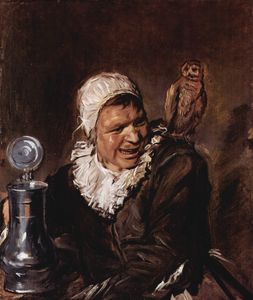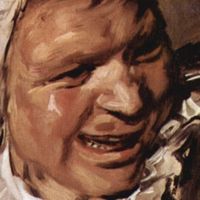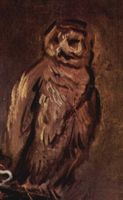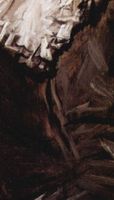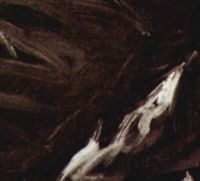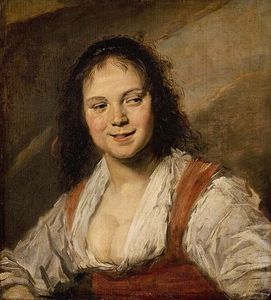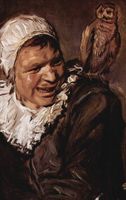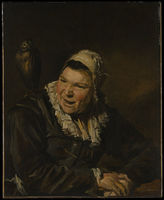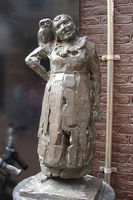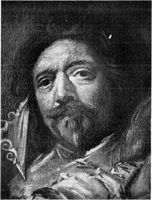Malle Babbe
- Date of Creation:
- 1633
- Alternative Names:
- The Haarlem Witch, Hille Bobbe
- Height (cm):
- 75.00
- Length (cm):
- 64.00
- Medium:
- Oil
- Support:
- Canvas
- Subject:
- Figure
- Art Movement:
- Baroque
- Created by:
- Current Location:
- Berlin, Germany
- Displayed at:
- Gemäldegalerie Berlin
- Owner:
- Gemäldegalerie Berlin
Malle Babbe Story / Theme
Malle Babbe refers to a folkloric character also known as the Haarlem Witch or Crazy Witch. Due to a misreading of an inscription on the inside of the picture frame, the painting was for many years known as Hille Bobbe.
This painting depicts a rather unconventional appearance of the subject; Malle Babbe was a very popular barmaid in Haarlem who most likely worked in one of the wealthy Civic Guard's taverns. Here she is portrayed as an old woman, gripping a metal beer mug with an owl perched on her left shoulder. This unusual image led many to label Malle Babbe a witch.
The folkloric tale of Malle Babbe lives on in Dutch culture and is used to describe someone who is loose and crazy. It has even become the subject of a song, describing the wild ways of Malle Babbe in her youth who, like many barmaids of this time was believed to be a prostitute.
Malle Babbe was a common drunk and was perceived as a wicked character who would seduce men and conduct herself in a rather unrespectable manner. She came alive at night and lured innocent men with her powers of seduction by lifting her skirt on the street and making men sell their souls to her. Her sexuality is likened to a wild animal with no control.
Frans Hal's image is of Malle Babbe in her old age, still glowering in the taverns. It's believed that she was not impressed with the title and image as it was recorded. Babbe suffered from Korsakov syndrome which causes the eyes muscles to weaken and relax and this would probably explain the subject's heavy eyes folds and small appearance.
Records show that Malle Babbe went on to be reinstated to a mental institution in Haarlem as she became uncontrollable and dangerous as a result of her heavy drinking.
Malle Babbe Inspirations for the Work
After a great deal of research in the municipality of Haarlem it was found that a real Malle Babbe actually existed. She was listed as a resident of the Het Dolhuys work house which housed the mentally ill. Hals would have got to know Malle Babbe in around 1642 because his son, Pieter Hals, was also in this work house.
Hals was a portrait artist through and through and so the opportunity to paint Malle Babbe, a well-known local figure at this time would have appealed to him. In true Hals' style he captures fleeting moments of gaiety in this canvas, namely Babbe's silly grin.
Malle Babbe Analysis
This work is believed to be Hals' most well-defined character pieces.
Hals had chosen to insert the image of an owl upon the woman's shoulder to accentuate the character of Malle Babbe and to emphasize her personality.
The owl represents the ancient folklore of witchcraft and drunkenness, as it comes to symbolize being active in the night just as Malle Babbe's crude character was. In the day time the bird is slow and inefficient, just as Malle Babbe's persona as she was definitely a creature of the night.
The owl also denotes erotic behavior as it is a symbol of the night and represents darkness, a time when daytime formalities are broken and people are more relaxed.
Brush stroke:
This work shows Hals' spontaneity through his suggestive brush work. He looks to separate the concept of the picture and reality by inserting blurry yet strong strokes and blatant daubing to evoke emotion.
Hals strokes are hard and brash due to his erratic use of the brush. This technique also captures the buzz inside the tavern itself, as the nightlife becomes rowdy and chaotic.
Color palette:
Hals uses white loosely to define light upon the colors in the picture. However, it is the use of browns that dominate this canvas as Hals uses multi-layering in the fabric folds of Malle Babbe's dress; he even uses it in the tankard to create reflection on the surface.
The artist uses strong strokes of brown to add depth and movement. Darker browns in harsh overtones are used to create the shadow on the wall behind the subject as well.
Composition:
The composition of this work is tight in order to convey the overcrowded tavern. Besides the candle which flickers due to passersby, the old woman is situated near the wall, almost right up against it. The overbearing shadows to the top create a sense of claustrophobia.
Malle Babbe Critical Reception
Frans Hals focused his attention on genre paintings of real life scenarios in Haarlem; gypsies, drunkards and women working. He was fascinated by people and depicted his image as well as his perception of it.
This meant that works such as Malle Babbe set Hals apart from his peers thanks to his unique painting style and technique. Although he created his works using successive layers, which was traditional at this time, he applied his underpainting very loosely and was able to pull back his hands from the canvas or panel at key moments.
Hals was skilled in being able to avoid overpainting his works in terms of accuracy and diligence, unlike many of his contemporaries.
Hals somewhat sketchy paintings were original in their vivacity and fitting characterization. Malle Babbe is generally perceived as Hals' most well-defined character pieces but many argue that it lacks the close attention to detail of his other commissioned works. Here it seems that the artist's freedom for expression was more important that the patron's tastes and preferences.
Yet, despite this, Malle Babbe is produced in a style very close to Impressionism an art style that did not emerge until two centuries later. For this reason, the Impressionists regarded Hals as their predecessor.
Malle Babbe Related Paintings
Malle Babbe Artist
Malle Babbe is a great representation of Hals' talent in characterization and is largely regarded as his most well-defined character piece. Yet, many critics feel it lacks close attention to detail and argue that some features, such as the owl, are poorly executed.
Despite this, it cannot be denied that in Malle Babbe Hals typically demonstrates his understanding of his subject and he captures Malle Babbe's essence.
Many Dutch schools went on to teach Hal's work methods in the two centuries after his death and he inspired many great artists, namely the Impressionists who developed his style and techniques.
Malle Babbe Art Period
Dutch Baroque has become the most noted era in art. Artists were able to freely choose their subject matter and how they wanted to express is and this resulted in artist excelling in creating new art styles and techniques. Thus, the Dutch were prospering not only in society and economically but also in their art and culture.
Deriving the Baroque style from Italy, the predominantly Protestant Dutch society would not allow the presentation or idolization of religious or biblical figures in paintings, instead favoring more conservative themes. This resulted in the Dutch focusing on more realistic painting and defining new concepts in portraiture, characterization, landscapes and still life.
Malle Babbe Bibliography
Find out more about Frans Hals and his unique works by referring to the recommended sources below.
• Baard, H. P. Frans Hals (Library of Great Painters). Thames & Hudson Ltd. , 1981
• Davies, Gerald. S. Frans Hals. George Bell and Sons, 1902
• Ekkart, Rudi & Buvelot, Quentin. Dutch Portraits: The Age of Rembrandt and Frans Hals. National Gallery Company Ltd. , 2007
• Grimm, Claus. Frans Hals: The Complete Work. Harry N. Abrams, Inc. , 1990
• Kernan, Michael. The Lost Diaries of Frans Hals: A Novel. Saint Martin's Press, 1995
• Slive, Seymour. Frans Hals. Alan Wofsy Fine Arts, 1989
• Trivas, N. S. The Paintings of Frans Hals. George Allen and Unwin Ltd; First Edition edition 1941

